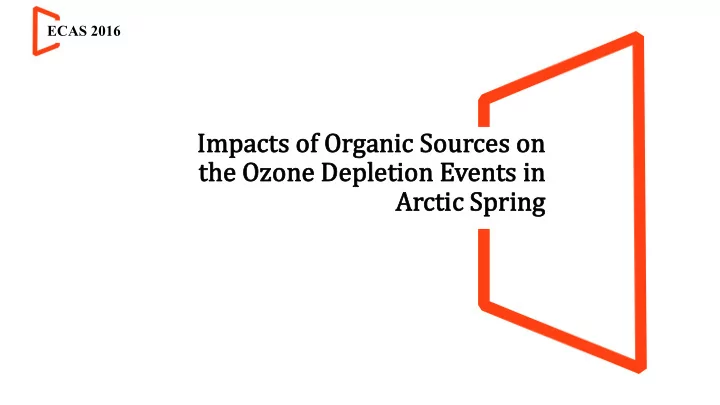

ECAS 2016 Impacts of Organic Sources on the Ozone Depletion Events in Arctic Spring
CONTENTS 01 02 03 Introduction Bromine Nitrogen Model Implementation 04 05 Results & Conclusions Discussion
Part 1 Introduction
Bromine Explosion Air Phase Condensed Phase Alert, Canada (Bottenheim et al., 1986) HOBr-BrO-Br Reaction Cycle (Simpson et al., 2007) Ozone is consumed through a catalytic cycle.
Inorganic Sources Flux rates of organic sources. (Cao et al., 2014) Species Flux Rates [molec./(cm 2 ·s)] Major Origin H 2 O 2 1.0×10 8 Ice/Snow HCHO 6.0×10 7 Sea NO 1.6×10 7 Ice/Snow NO 2 1.6×10 7 Ice/Snow HONO 1.6×10 7 Sea
Organic Bromine Sources Natural Sources Artificial Sources Plants Shipping Traffic Animals & Microbes Biomass Burning Fire Retrdants Driling Fluid Marine Macro-Algaes Sea Weeds Terestrail Mosses Lichens Grasses Shrubs
Macro-Algaes Chukchi Sea, (Kevin et al., 2012) Antarctica, Feb 2012 (NASA) Marine Eisenia arborea Species Egregia menziesii Nitzschia stellata Terrestrial Porosora pseudodenticalata Species
KINAL d c c 0 c t 0 f ( c , k ) F dt k, F c c d 4 th Runge-Kutta Order Method dt t Differential Equation (1) c : Concentration Solution: c t k : Reaction rate F : Flux
Part 2 Bromine Model
Algal Emission Estimation Based on Observation Laboratory Research (Cota et al., 1997) (Carpenter et al., 2000) CHBr 3 1.7×10 2 124~5434ng CHBr 3 /(g dry weight·h) CH 2 Br 2 2.8 CH 3 Br 0.1 5.3×10 7 (Gg/yr) Observation (Pihl et al., 1996) molec. Br/(cm 2 ·s) Biomass density is under 300g dry weight/m 2 in early spring. Macro-algaes produce 70% of world's bromoform.
Tundra Plants Emission Moss+Lichen=350g dwt/m 2 (Almost same productivity as algaes) Simulated temporal evolution of tundra biomass (Chapin et al., 1995) Total bromine flux= 6.3×10 7 molec. Br/(cm 2 ·s) after spatial mean.
Part 3 Nitrogen Implementation
Nitrogen Emission 0.5~1 nmol/(mg chlorophyll·h) (Tischner et al., 2004) NO chlorophyll density=6~18 mg/m 2 (Cota et al., 1997) i.e. NO=5 × 10 7 ~3 × 10 8 molec. /(cm 2 ·s) N 2 O Assumption: NO Flux= 1×10 8 molec. /(cm 2 ·s)
Part 4 Results & Discussions
Inorganic Only Inorganic Only complete ozone depletion: 5.4 days
Organic Bromine HOBr Input Organic HOBr/Br 2 Input complete ozone depletion: 4.2 days Br 2 Input
Source Component HOBr – Br 2 Portion of Br 2 does not make much importance. s.t. Take assumption: HOBr/Br 2 =6/2 (6/4 in bromine count)
Role of Br HOBr+ h ν → Br+OH photolysis 1 → 1 HOBr+HBr → Br 2 +H 2 O heterogeneous 1 → 2 HOBr+H + +Br - → Br 2 +H 2 O heterogeneous 1 → 2 The photolysis process is the principal bromine reaction in the induction stage.
Impact of Br Input Peak time and values of gaseous species, and stage beginning time under average level of organic source input. The induction stage is shortened for ~1.2 days, while the other stages are not significantly influenced.
Br Source Intensity Br Source Intensity There is a limit to the induction stage reduction.
Impact of N Peak time and values of specific events under different organic source input, as the organic source consists of average level of Br and N input at the same time. N input addresses minor influence on the atmospheric ozone. Simulated temporal volution of specific species under (top) Inorganic Sources Only, (mid) Inorganic and Br Sources, and (bott) Inorganic and complete organic sources.
Impact of N PAN (CH 3 COONO 3 ) is the principal N sink. N input modifies the Br chemistry, transforming HBr to BrNO 2 . Simulated temporal evolution of (top) bromine species, and (bott) nitrogen species after nitrogen implementation.
Br Source Intensity Prediction: For NO input>1.5×10 8 molec. /(cm 2 ·s),BrNO 2 becomes the major atmospheric bromine.
Part 5 Conclusions
Conclusions The natural organic source involved in the KINAL simulation consists Br and N input. Br input is a mixing emission of HOBr and Br 2 . An average level of Br input causes a 1.2 days antedate to the induction stage of the ODE, which lasts 4.4 days under inorganic sources only. The depletion and end stages are not obviously influenced. N input is the NO emitted by various plants. Other than the negligible enhancement on the ozone depletion, NO input modifies the bromine chemistry to a great extent.
Q&A Q&A
Recommend
More recommend